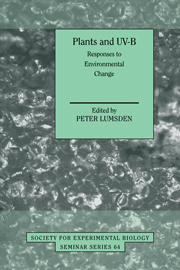Book contents
- Frontmatter
- Contents
- List of contributors
- Preface
- PART I The ozone layer and UV-B radiation
- Global ozone depletion: observations and theory
- Monitoring changes in UV-B radiation
- Action spectra for UV-B effects on plants: monochromatic and polychromatic approaches for analysing plant responses
- PART II Effects of UV-B on plants at the cellular level
- PART III Effects of UV-B at the whole plant and community level
- Index
Action spectra for UV-B effects on plants: monochromatic and polychromatic approaches for analysing plant responses
Published online by Cambridge University Press: 04 August 2010
- Frontmatter
- Contents
- List of contributors
- Preface
- PART I The ozone layer and UV-B radiation
- Global ozone depletion: observations and theory
- Monitoring changes in UV-B radiation
- Action spectra for UV-B effects on plants: monochromatic and polychromatic approaches for analysing plant responses
- PART II Effects of UV-B on plants at the cellular level
- PART III Effects of UV-B at the whole plant and community level
- Index
Summary
Introduction
Small increases in solar ultraviolet-B (UV-B; 280–320 nm) radiation can have substantial effects on the growth and development of many plant species. As a result of a reduction in stratospheric ozone, UV-B radiation has been increasing over Europe for at least a decade, and current evidence points to a gradual increase in incident solar UV-B over Europe at a rate of about 1% per annum (Blumthaler & Ambach, 1990; Ambach & Blumthaler, 1991; WMO Ozone Report Summary, 1994). Over the course of the year, ozone depletion is variable, with the main decrease occurring in late winter and early spring; although total UV-B is much less at this time than during summer, the proportional increase is greatest during spring and is therefore mainly of threat to crops and other plants growing at this time.
Understanding the impacts of this increase on plants requires appropriate action spectra. In approximate terms, an action spectrum indicates the relative effectiveness of different wavelengths of radiation in bringing about a particular response. The relative effectiveness, derived from the action spectrum, can then be multiplied by the irradiance at each wavelength, and summed over the appropriate wavelength range to give the important function, biologically effective radiation. This term will be found throughout this volume; usually it will have been derived from the Caldwell generalised plant action spectrum and be normalised at 300 nm (PAS300). It should be noted that other action spectra are sometimes used.
- Type
- Chapter
- Information
- Plants and UV-BResponses to Environmental Change, pp. 31 - 50Publisher: Cambridge University PressPrint publication year: 1997
- 28
- Cited by



